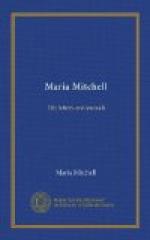It was, at first, held in the evening, but during the last years was a breakfast party, its character in other respects remaining the same. Little tables were spread under the dome, around the big telescope; the flowers were roses from Miss Mitchell’s own garden. The “poems” were nonsense rhymes, in the writing of which Miss Mitchell was an adept. Each student would have a few verses of a more or less personal character, written by Miss Mitchell, and there were others written by the girls themselves; some were impromptu; others were set to music, and sung by a selected glee-club.
“June 5, 1881. We have written what we call our dome poetry. Some nice poems have come in to us. I think the Vassar girls, in the main, are magnificent, they are so all-alive....
“May 20, 1882. Vassar is getting pretty. I gathered lilies of the valley this morning. The young robins are out in a tree close by us, and the phoebe has built, as usual, under the front steps.
“I am rushing dome poetry, but so far show no alarming symptoms of brilliancy.”
A former student writes as follows about the dome poetry:
“At the time it was read, though it seemed mere merry nonsense, it really served a more serious purpose in the work of one who did nothing aimlessly. This apparent nonsense served as the vehicle to convey an expression of approbation, affection, criticism, or disapproval in such a merry mode that even the bitterest draught seemed sweet.”
“1881, July 5. We left Vassar, June 24, on the steamer ‘Galatea,’ from New York to Providence. I looked out of my state-room window, and saw a strange-looking body in the northern sky. My heart sank; I knew instantly that it was a comet, and that I must return to the observatory. Calling the young people around me, and pointing it out to them, I had their assurance that it was a comet, and nothing but a comet.
“We went to bed at nine, and I arose at six in the morning. As soon as I could get my nieces started for Providence, I started for Stonington,—the most easy of the ways of getting to New York, as I should avoid Point Judith.
“I went to the boat at the Stonington wharf about noon, and remained on board until morning—there were few passengers, it was very quiet, and I slept well.
“Arriving in New York, I took cars at 9 A.M. for Poughkeepsie, and reached the college at dinner-time. I went to work the same evening.
“As I could not tell at what time the comet would pass the meridian, I stationed myself at the telescope in the meridian-room by 10 P.M., and watched for the comet to cross. As it approached the meridian, I saw that it would go behind a scraggy apple-tree. I sent for the watchman, Mr. Crumb, to come with a saw, and cut off the upper limbs. He came back with an axe, and chopped away vigorously; but as one limb after another fell, and I said, ‘I need more, cut away,’ he said, ’I think I must cut down the whole tree.’ I said, ‘Cut it down.’ I felt the barbarism of it, but I felt more that a bird might have a nest in it.




